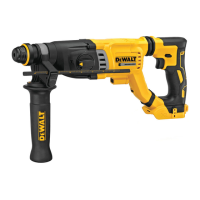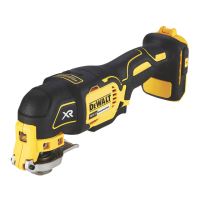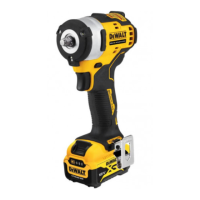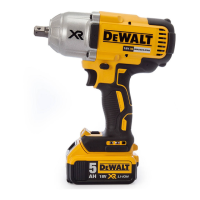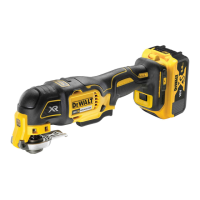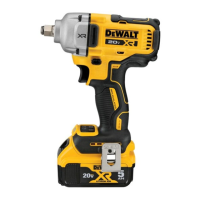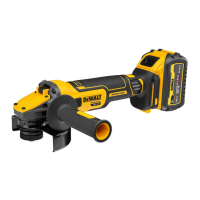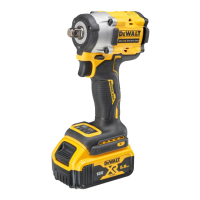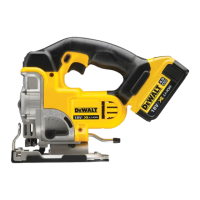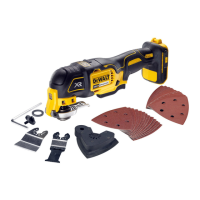32
ENGLISH
To Install the Battery Pack into the Tool
Handle
1. Align the battery pack
1
with the rails inside the tool’s
handle (Fig. B).
2. Slide it into the handle until the battery pack is firmly seated
in the tool and ensure that you hear the lock snap intoplace.
To Remove the Battery Pack from the Tool
1. Press the release button
2
and firmly pull the battery pack
out of the toolhandle.
2. Insert battery pack into the charger as described in the
charger section of thismanual.
Fuel Gauge Battery Packs
Some DeWALT battery packs include a fuel gauge which consists
of three green LED lights that indicate the level of charge
remaining in the batterypack.
To actuate the fuel gauge, press and hold the fuel gauge
button
12
. A combination of the three green LED lights will
illuminate designating the level of charge left. When the level of
charge in the battery is below the usable limit, the fuel gauge
will not illuminate and the battery will need to berecharged.
NOTE: The fuel gauge is only an indication of the charge left on
the battery pack. It does not indicate tool functionality and is
subject to variation based on product components, temperature
and end-userapplication.
Side Handle (Fig. A)
WARNING: To reduce the risk of personal injury, ALWAYS
operate the tool with the side handle properly installed.
Failure to do so may result in the side handle slipping
during tool operation and subsequent loss of control. Hold
tool with both hands to maximizecontrol.
The side handle
3
clamps to the front of the gear case and may
be rotated 360˚ to permit right- or left-hand use. The side handle
must be tightened sufficiently to resist the twisting action of
the tool if the accessory binds or stalls. Be sure to grip the side
handle at the far end to control the tool during astall.
To loosen side handle, rotatecounterclockwise.
Bit and Bit Holder
WARNING: Burn Hazard. ALWAYS wear gloves when
changing bits. Accessible metal parts on the tool and bits
may get extremely hot during operation. Small bits of
broken material may damage barehands.
The hammerdrill can be fitted with different bits depending on
the desired application. Use sharp drill bitsonly.
SDS-Max® Bit Holder (Fig. C)
To insert a drill bit or other accessory:
1. Insert the shank of the bit about 19mm into SDS-Max tool
holder
8
.
2. Push and rotate bit until it locks in place. The bit will be
securelyheld.
3. To release bit, pull the sleeve
9
back and remove thebit.
SDS plus® and SDS max® are registered trade marks of
RobertBoschGmbH.
OPERATION
Instructions for Use
WARNING: Always observe the safety instructions and
applicableregulations.
WARNING: To reduce the risk of serious personal
injury, turn tool off and disconnect battery pack
before making any adjustments or removing/
installing attachments or accessories. An accidental
start-up can causeinjury.
Proper Hand Position (Fig. F)
WARNING: To reduce the risk of serious personal injury,
ALWAYS use proper hand position asshown.
WARNING: To reduce the risk of serious personal
injury, ALWAYS hold securely in anticipation of a
suddenreaction.
Proper hand position requires one hand on the side handle,
with the other hand on the mainhandle. Hold tool firmly with
both hands to control the twisting action of thedrill.
Operation Modes (Fig. A, E)
WARNING: Do not select the operating mode when the
tool isrunning.
Your tool is equipped with a mode selector dial
5
to selectthe
mode appropriate to desiredoperation.
Symbol Mode Application
Rotary Drilling Dry diamond coring
Rotary
Hammering
Drilling into concrete and
masonry
Hammering
only
Lightchipping
To select an operating mode:
1. Depress the mode selector release button
6
.
2. Rotate the mode selector dial so that the arrow points to the
symbol corresponding with the desiredmode.
NOTE: The mode selector
5
must be in rotary drilling, rotary
hammering or hammering only mode at all times. There are no
operable positions inbetween. It may be necessary to briefly
run the motor after having changed from 'hammering only' to
'rotary' modes in order to align thegears.
Performing an Application (Fig. A, F)
WARNING: TO REDUCE THE RISK OF PERSONAL
INJURY, ALWAYS ensure workpiece is anchored or
clamped firmly. If drilling thin material, use a wood “back-
up” block to prevent damage to thematerial.
WARNING: Always wait until the motor has come to
a complete standstill before changing the direction
ofrotation.
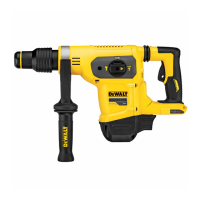
